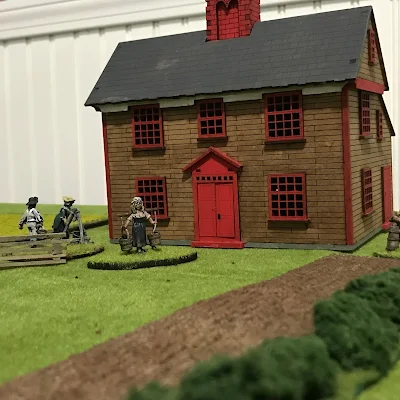The game starts on turn one with Captain Laurie's detachment guarding the bridge. Colonel Barrett's Militia and Minute Man battalions are just arriving in the hillside overlooking the bridge. Captain Laurie quickly sends a message to town to send reinforcements (they will arrive on the board on turn six). For the next two turns the Colonists hold a town meeting to debate what to do (i.e.more then half the units must pass a morale test to march towards the bridge).
On turn three the radical firebrand Colonel John Carroll arrives.
His stirring speech to oppose the red coated tyrants is met with cheers and cries from one Minute Captain of "I haven't a man who's afraid to go." Forming columns the companies march down towards the bridge.
Captain Laurie retires to the east side of the bridge and extends his men along the bank. Where is Smith with the reinforcements! Colonel Carroll leds from the front and the colonists steadily draw nearer.
Looking to Colonel Carroll for leadership he advised three battalions march to the bridge while one battalion set up to watch the Red coats who went to Barrett's farm. On turn five the militia and minute men arrive at the bridge. Both sides are deployed along the banks and ready for a fight. Laurie wonders aloud where is Smith? Looking over there shoulders they can just make out the reinforcements marching up the road.
The British fire a few warning shots (actually it was long range and they missed but this sounds better).
Both sides are in range and deployed and open fire. Heavy casualties all around but both sides pass their morale checks. Next move Smith hurried the Grenadiers into place and both sides continued the small arms fire again with casualties mounting. One militia battalion is shaken but Colonel Carroll rallies them.
On turn 10 Captain Person's detachment arrives on the board! The waiting Minute battalion is ready and opens fire giving the British a warm welcome.
At the bridge casualties mount on both sides with Smith and Carroll trying to rally their men. First one militia battalion breaks and runs. Then the light infantry detachment breaks and runs. Smith and the Grenadiers stand fast and continues to hold the bridge open.
Although shadowed by two battalions Parsons continues to retire and fire.
Finally the casualties are too much and the second minute battalion breaks.
The bridge is open and Parson races to cross to safety. Smith, satisfied with the result fires a last volley and covers the march back to Concord. The two remaining militia battalions move cautiously forward but there is no hope to cut off the lights. Better to think about how to continue the fight later when the British have to march back to Boston.
Conclusion:
A most enjoyable game. The difference in quality if troops was the final decision in who one. In fact I am surprised that the Minute battalions held on as well and as long as they did. Perhaps that was due to the outstanding leadership of Colonel John Carroll!

















.jpeg)


.jpeg)























.jpeg)







